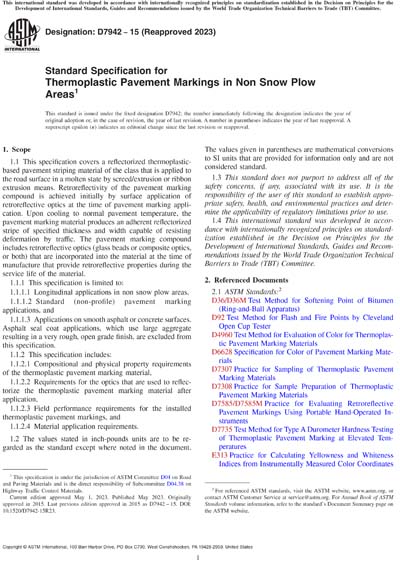Most recent
ASTM D7942-15(2023)
Standard Specification for Thermoplastic Pavement Markings in Non Snow Plow Areas
1.1This specification covers a reflectorized thermoplastic-based pavement striping material of the class that is applied to the road surface in a molten state by screed/extrusion or ribbon extrusion means. Retroreflectivity of the pavement marking compound is achieved initially by surface application of retroreflective optics at the time of pavement marking application. Upon cooling to normal pavement temperature, the pavement marking material produces an adherent reflectorized stripe of specified thickness and width capable of resisting deformation by traffic. The pavement marking compound includes retroreflective optics (glass beads or composite optics, or both) that are incorporated into the material at the time of manufacture that provide retroreflective properties during the service life of the material.
1.1.1This specification is limited to:
1.1.1.1Longitudinal applications in non snow plow areas,
1.1.1.2Standard (non-profile) pavement marking applications, and
1.1.1.3Applications on smooth asphalt or concrete surfaces. Asphalt seal coat applications, which use large aggregate resulting in a very rough, open grade finish, are excluded from this specification.
1.1.2This specification includes:
1.1.2.1Compositional and physical property requirements of the thermoplastic pavement marking material,
1.1.2.2Requirements for the optics that are used to reflectorize the thermoplastic pavement marking material after application,
1.1.2.3Field performance requirements for the installed thermoplastic pavement markings, and
1.1.2.4Material application requirements.
1.2The values stated in inch-pounds units are to be regarded as the standard except where noted in the document. The values given in parentheses are mathematical conversions to SI units that are provided for information only and are not considered standard.
1.3This standard does not purport to address all of the safety concerns, if any, associated with its use. It is the responsibility of the user of this standard to establish appropriate safety, health, and environmental practices and determine the applicability of regulatory limitations prior to use.
1.4This international standard was developed in accordance with internationally recognized principles on standardization established in the Decision on Principles for the Development of International Standards, Guides and Recommendations issued by the World Trade Organization Technical Barriers to Trade (TBT) Committee.
Content Provider
ASTM International [astm]






